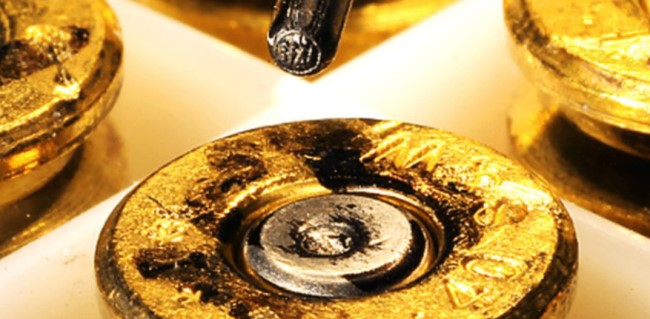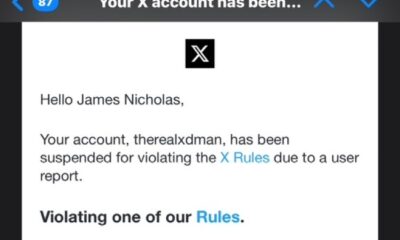Sh*t Anti-Gunners Say
NSSF: Moronic Myths of Microstamping

Image courtesy NSSF
“Microstamping” is one of the gun-grabbers’ biggest “gimmes.”
Over the years, American anti-gunners have spent a great deal of time, money, and political capital trying to get laws passed that mandate “microstamping.” It’s a technology that, even in theory, is unlikely to ever solve any crimes and will only serve as a terrible burden on law-abiding gun owners. Today, the National Shooting Sports Foundation‘s Larry Keane explains why. Be sure to bookmark this article to send to your friends the next time someone lays the old “But if it saves just one life!” line on you…
_____________________________________________________________________________________
By Larry Keane
Microstamping has reared up as gun control schemers elevate it as a sophisticated means of “gun safety,” a sly euphemism for gun control. Proponents of the unworkable, unreliable and ineffective concept keep their heads in the sand regarding the feasibility of microstamping mandates because they can’t face the truth. It doesn’t work.
Boondoggle Backstory
Microstamping is unproven and unworkable technology, using a laser to imprint a shallow unique identifying code on a handgun’s firing pin, transferring the mark to a spent cartridge casing once it has fired. Gun control politicians push the “technology” to “reduce gun violence.” In their minds, microstamping connects the dots on crime, a criminally misused firearm and the criminal. Except that’s not realistic and forcing gun manufacturers to implement microstamping on new guns, or retrofit existing firearms, only limits lawful firearm ownership.
Todd Lizotte, who holds the patent for the sole-source microstamping technology, recognized this reality in a peer reviewed study. “Legitimate questions exist related to both the technical aspects, production costs, and database management associated with microstamping that should be addressed before wide scale implementation is legislatively mandated.”
Third-party researchers agree. Forensic firearms examiner Professor George Kristova wrote, “Implementing this technology will be much more complicated than burning a serial number on a few parts and dropping them into firearms being manufactured.” The University of California at Davis, hardly a gun rights redoubt, reported, “At the current time it is not recommended that a mandate for implementation of this technology be made.”
A National Academy of Science study concluded that “the durability and survivability of markings on the bullet are still major concerns. Bullets would also be likely to suffer the corrosive effects of blood and other substances.” An Iowa State University study stated that “legitimate questions exist related to the technical aspects, production costs and database management associated with microstamping that should be addressed before wide scale implementation is legislatively mandated.”
That bottom line is microstamping doesn’t work. Lizotte himself agreed that alphanumeric codes are often illegible under even perfect conditions. Electron microscopes couldn’t detect legible codes in testing. Even under perfect conditions, it would take at least 10 spent cartridges make an “educated guess” to piece together a legible code. More practically, this technology can easily be defeated with sandpaper or a nail file as the microstamping mark is only 25 microns (half the diameter of a human hair). Criminals already obliterate serial numbers etched into a firearm frame.
Little Digits, Big Problems
California ignored these impossibilities and passed a dual-placement microstamping mandate in 2007, despite the firearm industry testifying the technology doesn’t work. Then-California Attorney General and now Vice President Kamala Harris certified the law in 2013, along with California’s Roster of Handguns Certified for Sale. Since then, firearm manufactures have introduced no new handguns to California. Democratic Gov. Gavin Newsom signed AB 2847 into law in 2020, reducing the microstamping requirement to a single place, but speeding up the number of handguns falling off the list of those approved for sale in California. For every new handgun added to California’s Roster of Handguns Certified for Sale, three older models must be removed. When the initial microstamping law took effect, there were 953 pistols on the roster. As of November 2020, there are only 497, as any modification to a model even to improve the safety and reliability of a handgun constitutes a new model requiring microstamping.
California Dreaming
California is the only state to enact microstamping, but other states are considering it. Connecticut tried once before in 2009 but the bill was defeated. Democratic state Rep. Jillian Gilchrist introduced HB 5584, trying to require the impossible technology in her state again this year.
California’s considering going back to dual-placement requirements, which it just rolled back a year ago. Democratic Assemblyman David Chiu, who wrote the single-placement law, introduced a bill just weeks ago to up the requirement back to two places on a cartridge. It’s still unworkable and the requirement to speed up the removal of handguns off the roster remains. It was never about solving crime. It has always been about eliminating handguns.
On the federal level, microstamping legislation was introduced in the U.S. House of Representatives in 2008 by then-Congressman Xavier Beccera (D-Calif.), who became California’s attorney general after Vice President Harris won election to the Senate. Becerra is now President Joe Biden’s Health and Human Services Secretary nominee awaiting U.S. Senate approval. He would join an administration itching to throw roadblocks in front of the firearm industry and deprive law-abiding Americans the ability to exercise their Second Amendment rights.
-

 Smells Like Infringement1 month ago
Smells Like Infringement1 month agoCensored! Check Out the Gun Meme That Got Me Perma-Banned from Twitter/X
-

 Gun Rights2 months ago
Gun Rights2 months agoLet’s See If Lefties Think the Brady Campaign is “Above the Law”
-

 2A's Lighter Side2 months ago
2A's Lighter Side2 months agoOpen Your Mouth & Close Your Eyes! Here’s Another Anti-Gun USAID Surprise …
-

 Gun Rights3 weeks ago
Gun Rights3 weeks agoDOJ Tells Anti-Gun Illinois to Stop Eating Paint
-

 Smells Like Infringement2 weeks ago
Smells Like Infringement2 weeks agoMarriage Made in Hell: Let’s NOT Merge ATF & DEA
-

 Gun Rights4 weeks ago
Gun Rights4 weeks agoRELOADED! NRA 2.0 Comes Out Swinging in 2025
-

 Laws & Rights1 month ago
Laws & Rights1 month agoThe Ides of March for Our Lives
-

 Guns Save Lives1 week ago
Guns Save Lives1 week agoIndependence Day Couldn’t Have Happened Without Armed Citizens




